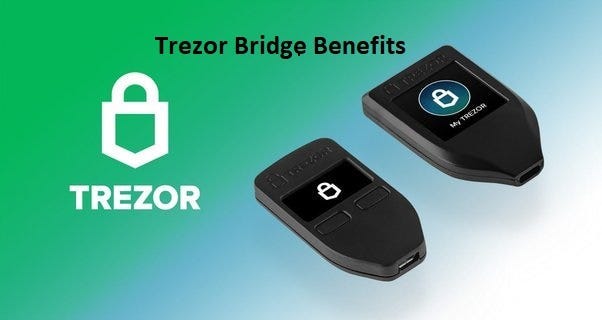
🔒 trezor bridge — simple, secure connection
trezor bridge is the lightweight application that allows your Trezor hardware wallet to communicate securely with your computer and browser. Whether you're updating firmware, signing transactions, or accessing your crypto through Trezor Suite or supported web wallets, trezor bridge makes the connection seamless and reliable.
⚙️ What is trezor bridge?
trezor bridge is a small background program that creates a secure channel between your Trezor device and web-based applications. It handles device detection, message passing, and ensures that websites cannot directly access your hardware without your permission. Install trezor bridge and you get a trusted local endpoint that Trezor Suite and other wallet interfaces can use.
🛡️ Why use trezor bridge?
trezor bridge improves security and user experience. With trezor bridge, you avoid unreliable browser extensions or complicated driver installs. The bridge verifies device fingerprinting, offers signed communication, and reduces friction when connecting to different browsers or operating systems. For everyday users and advanced traders alike, trezor bridge streamlines workflow while keeping private keys safely on the device.
📥 Installing trezor bridge
To install trezor bridge, download it from the official Trezor site or follow the installer prompts in Trezor Suite. Choose the appropriate installer for Windows, macOS, or Linux and allow the bridge to run in the background. Once installed, trezor bridge will detect your Trezor automatically when plugged in and display approval prompts in Trezor Suite or supported web wallets so you can confirm actions directly on-device.
🔄 Updating and troubleshooting trezor bridge
Keep trezor bridge up to date to maintain compatibility with the latest firmware and features. If your device isn't detected, restart the bridge service, try a different USB cable or port, and ensure your browser allows local connections. Many common connection problems are resolved by reinstalling trezor bridge or restarting your computer. For persistent issues, consult official guides or support channels.
🔐 Security considerations for trezor bridge
Because trezor bridge runs locally and handles sensitive requests, install only from official sources. trezor bridge never exposes your seed phrase or private keys — all signing happens on the hardware device. Verify software signatures where available and confirm prompts on your Trezor screen before approving transactions. Using trezor bridge with updated firmware and Trezor Suite maximizes security.
💡 Best practices when using trezor bridge
Always confirm the destination address on your Trezor device, keep trezor bridge updated, and avoid installing third-party bridge-like tools from unknown sources. Use a secure machine free of malware, enable passphrase protection if desired, and back up your recovery seed safely offline. trezor bridge makes access easier, but your personal and device hygiene remains critical.
🔗 Compatibility and browser support for trezor bridge
trezor bridge is compatible with major browsers and operating systems. If a website requests access to your Trezor, the browser will communicate through trezor bridge to open a secure session. Support is broad but check official compatibility notes for older systems. For web developers, integrating with trezor bridge requires following the Trezor Connect API and respecting user consent flows.
🧭 Using trezor bridge for everyday tasks
From sending coins to signing smart contract interactions, trezor bridge acts as the reliable conductor between your hardware and the apps you trust. When you connect your Trezor, trezor bridge will prompt you with familiar, secure dialogues and only complete operations once you confirm actions physically on the device. This separation ensures that even if your computer is compromised, your keys remain safe.
❓ Frequently asked questions about trezor bridge
Q: Is trezor bridge safe to run on my computer?
Yes. trezor bridge runs locally and facilitates communication between your device and applications without storing private keys or recovery phrases. Cryptographic signing happens on your Trezor device, and trezor bridge only relays messages between the browser and the hardware securely.
Q: What if trezor bridge stops detecting my device?
Try reconnecting the USB cable, switching ports, restarting the bridge service, and ensuring both bridge and firmware are up to date. Reinstalling trezor bridge from official sources often resolves stubborn issues.
Q: Will trezor bridge work with different wallets?
Yes. trezor bridge is commonly used together with Trezor Suite and other wallets that support the Trezor Connect API. Check individual wallet compatibility if unsure, but trezor bridge is broadly supported.
📝 Quick user tips for trezor bridge
Keep a dedicated USB cable for your Trezor, avoid public or shared machines when approving transactions, and enable system backups where appropriate. If you frequently switch between devices, maintain a checklist: update bridge, update firmware, test with Trezor Suite, and always confirm on-device prompts. These simple steps reduce friction and keep your trezor bridge experience smooth and secure.
🧾 Keep trezor bridge updated
Check official release notes for updates and security fixes. Trezor Suite often prompts users to update, but manual checks are recommended for power users managing multiple machines.
📌 Final summary — trezor bridge
trezor bridge is a secure, lightweight service that makes hardware wallet use smooth and convenient. It preserves the safety model of on-device signing while simplifying browser interactions and cross-platform compatibility. Install trezor bridge from trusted sources, keep it updated, and always verify actions on your Trezor device to retain maximum security and convenience.
Need a quick action? Install trezor bridge